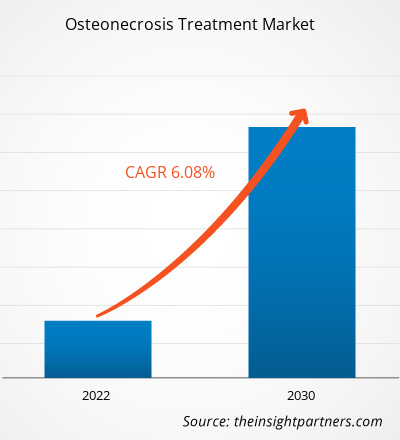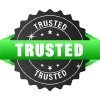[調査レポート] 骨壊死治療市場規模は、2022年の6億3,718万米ドルから2030年には10億2,192万米ドルに成長すると予想されており、2022年から2030年にかけて市場は6.08%のCAGRを記録すると予測されています。
アナリストの視点
骨壊死治療市場分析では、交通事故の増加による骨壊死症例の増加や、患者によるステロイドの長期使用などの成長要因を説明しています。さらに、高齢者人口の増加と骨の健康に関する意識の高まりは、骨壊死治療市場の発展に有利に働いています。しかし、外科的治療の高コストと治療薬に関連するリスクが市場の成長を妨げています。整形生物学と再生療法の採用は、2022年から2030年にかけて骨壊死治療市場の将来のトレンドとして浮上する可能性があります。
骨壊死は、無血管性骨壊死 (AVN) とも呼ばれ、骨への血流が阻害されることで起こる痛みを伴う骨疾患です。この症状は時間とともに悪化し、骨細胞の死につながります。骨壊死のリスク要因には、骨折、股関節脱臼、放射線療法、アルコール乱用などがあります。
市場分析
整形外科的傷害の増加と高齢者人口の増加が骨壊死治療市場の成長を促進
Clevelandclinic.org が 2021 年に発表した統計によると、毎年 10,000~20,000 人のアメリカ人が AVN と診断されており、この症状はあらゆる年齢や性別の人に発生しています。股関節脱臼を経験した人の約 20% が無血管性骨壊死を発症します。致命的な事故による骨や関節の損傷が増加しているため、骨壊死の症例は世界的に増加しています。骨壊死は股関節によく見られますが、上腕骨、膝、距骨の状態にも悪影響を及ぼす可能性があります。StatPearls が 2023 年に発表した記事によると、AVN は米国における股関節形成術の 10% の原因であり、そのほとんどが 30~65 歳の人々です。股関節や膝が脱臼すると、脚への血液供給が遮断される可能性があります。その結果、脚の組織に十分な血液が供給されず(虚血と呼ばれる状態)、組織が死滅する(壊死と呼ばれる状態)可能性があります。肘や上腕の骨折は、前腕への血流を妨げることがあり、同様の合併症を引き起こします。骨への血液供給が遮断されると、骨の一部が死滅し、骨壊死を引き起こす可能性があります。2022年1月にPubMed Centralで発表された記事によると、170,934人の重大外傷患者を含むコホート研究が実施されました。この研究では、外傷性股関節脱臼を伴う重大外傷患者の78.0%が交通事故、特に自動車事故(49.9%)で負傷していると結論付けられました。
高齢者は骨の変性や骨折を起こしやすいため、骨壊死を経験する可能性が高くなります。2020年にPubMedで発表された論文では、大腿骨頸部骨折(FNF)の患者73人を対象に、カニューレ内固定の長期的転帰に対する有効性を評価するとともに、転帰に影響を与えるリスク要因を特定する研究が行われました。研究結果によると、これらの患者のうち7人(つまり約10%)が大腿骨頭壊死を経験し、そのうち4人が股関節置換術を受けました。世界保健機関(WHO)によると、2030年までに世界の6人に1人が60歳以上になり、推定14億人が60歳以上になると予想されています。したがって、急増する高齢者人口と骨の健康に関する意識の高まりは、骨壊死治療市場に有利に働きます。
要件に合わせてレポートをカスタマイズする
このレポートの一部、国レベルの分析、Excelデータパックなど、あらゆるレポートを無料でカスタマイズできます。また、スタートアップや大学向けのお得なオファーや割引もご利用いただけます。
- このレポートの主要な市場動向を入手してください。この無料サンプルには、市場動向から見積もりや予測に至るまでのデータ分析が含まれます。
今後の動向
骨壊死治療市場における将来のトレンドとして、整形生物学と再生療法の導入が浮上
オーソリジェネレーションは、生物学の利点を活用して治癒を促進し、痛みを軽減し、機能を改善し、組織再生に適した環境を作り出し、整形外科的疾患を治療する医療分野です。オーソリジェネレーションの原理に基づいて機能する介入的オーソバイオロジクスは、整形外科医療の分野に革命をもたらしています。オーソバイオロジクスは、骨髄や血液などの患者の組織から抽出されます。筋骨格損傷の治癒を刺激するシグナル伝達分子または細胞で構成されています。
幹細胞療法、多血小板血漿療法、成長因子、組織工学などの再生治療は、治療結果を最適化するために臨床試験で研究および評価されています。2023年1月にPubMed Centralで発表された記事では、この病気に苦しむ44歳の男性の両側大腿骨頭AVNの治療における生物学的製剤の使用を評価する研究が行われました。患者は右大腿骨頭に骨髄吸引濃縮液(BMAC)を、左大腿骨頭に成人自己生培養骨芽細胞を投与され、その後、数年間の追跡調査を受けるように求められました。この研究では、分化骨芽細胞を使用した生物学的療法は、未分化BMACカクテルと比較して、AVN大腿骨頭に対する実行可能な選択肢であると結論付けられました。
骨壊死治療市場の主要企業は、製品の発売とともに、革新的な治療法の研究開発に取り組んでいます。2021年2月、Additive Orthopedics, LLCは、世界初の人道的使用インプラントでもある初の患者固有の距骨スペーサーについて、米国食品医薬品局(FDA)の承認を取得しました。同様に、世界有数の医療機器会社であるArthrexは現在、特発性膝骨壊死(SONK)に対する骨内バイオプラスティ(IOBP)技術を提供しています。この技術では、病変のコア減圧を実施した後、Angel濃縮血小板多血漿(cPRP)システムを使用して調製された濃縮骨髄吸引液を直接適用します。
レポートのセグメントと範囲
「骨壊死治療市場」は、治療タイプ、エンドユーザー、および地域に基づいてセグメント化されています。製品タイプに基づいて、市場は医薬品と手術に分かれています。エンドユーザーの観点から、市場は病院、専門クリニック、外来手術センター、その他にセグメント化されています。骨壊死治療市場は、地域に基づいて、北米(米国、カナダ、メキシコ)、ヨーロッパ(ドイツ、フランス、イタリア、英国、ロシア、その他のヨーロッパ)、アジア太平洋(オーストラリア、中国、日本、インド、韓国、その他のアジア太平洋)、中東およびアフリカ(南アフリカ、サウジアラビア、UAE、その他の中東およびアフリカ)、および南米および中米(ブラジル、アルゼンチン、その他の南米および中米)にセグメント化されています。
治療タイプに基づく洞察
治療の種類に基づいて、骨壊死治療市場は薬物治療と手術に分類されます。薬物治療セグメントは2020~2030年に最高の市場シェアを占めました。ただし、手術セグメントは7.63%という最高のCAGRで成長すると予想されています。
エンドユーザーベースの洞察
エンドユーザーの観点から見ると、骨壊死治療市場は、病院、専門クリニック、外来手術センターなどに分類されます。病院セグメントは、2022年から2030年にかけて市場で最も高いCAGRを記録すると予想されています。骨壊死治療には、診断、治療、継続的なモニタリングなど、特別な医療的配慮を必要とする複雑な手術が含まれます。病院は、骨壊死患者に完全なヘルスケアサービスを提供する上で重要な役割を果たしています。病気の段階と重症度に応じて、病院は骨壊死のさまざまな治療オプションを提供します。これらの治療には、疼痛管理、理学療法、ライフスタイルの変更などの保存的技術が含まれる場合があります。さらに、重症例では、関節温存手術や関節置換手術などの外科的治療が行われる場合があります。
骨壊死治療市場の地域別洞察
予測期間を通じて骨壊死治療市場に影響を与える地域的な傾向と要因は、Insight Partners のアナリストによって徹底的に説明されています。このセクションでは、北米、ヨーロッパ、アジア太平洋、中東、アフリカ、南米、中米にわたる骨壊死治療市場のセグメントと地理についても説明します。

- 骨壊死治療市場の地域別データを入手
骨壊死治療市場レポートの範囲
| レポート属性 | 詳細 |
|---|---|
| 2022年の市場規模 | 6億3,718万米ドル |
| 2030年までの市場規模 | 10億2,192万米ドル |
| 世界のCAGR(2022年 - 2030年) | 6.08% |
| 履歴データ | 2020-2022 |
| 予測期間 | 2022-2030 |
| 対象セグメント | 治療の種類別
|
| 対象地域と国 | 北米
|
| 市場リーダーと主要企業プロフィール |
|
市場プレーヤーの密度:ビジネスダイナミクスへの影響を理解する
骨壊死治療市場は、消費者の嗜好の変化、技術の進歩、製品の利点に対する認識の高まりなどの要因により、エンドユーザーの需要が高まり、急速に成長しています。需要が高まるにつれて、企業は提供を拡大し、消費者のニーズを満たすために革新し、新たなトレンドを活用し、市場の成長をさらに促進しています。
市場プレーヤー密度とは、特定の市場または業界内で活動している企業または会社の分布を指します。これは、特定の市場スペースに、その規模または総市場価値と比較して、どれだけの競合相手 (市場プレーヤー) が存在するかを示します。
骨壊死治療市場で事業を展開している主要企業は次のとおりです。
- ノバルティスAG
- テバ製薬株式会社
- ジマーバイオメット
- ファイザー株式会社
- ストライカー
免責事項:上記の企業は、特定の順序でランク付けされていません。

- 骨壊死治療市場のトップキープレーヤーの概要を入手
地域分析
北米の骨壊死治療市場は、先進的な治療オプションの普及率の高さや、主要メーカーがこの地域に集中していることなどの要因により、予測期間中に大幅な成長が見込まれています。特に米国では、骨壊死治療の採用率が高くなっています。
このレポートでは、世界の骨壊死治療市場で活動する主要企業を紹介しています。これらの企業には、Novartis AG、Teva Pharmaceutical Industries Ltd.、Zimmer Biomet、Pfizer Inc.、Stryker、Exactech, Inc.、Merck & Co. Inc.、Dr. Reddy's Laboratories Ltd.、Viatris Inc、Horizon Therapeutics plc が含まれます。これらの主要企業は、市場での存在感と顧客層の拡大と多様化に注力しており、それによって骨壊死治療市場に存在するビジネス チャンスを捉えています。
主要な市場プレーヤーによる重要な動向のいくつかは次のとおりです。
- 2022年5月、Regrow Biosciencesは、OSSGROWの希少疾病用医薬品指定(ODD)を米国FDAと欧州医薬品庁(EMA)から取得しました。この薬は、骨壊死に苦しむ患者を対象としています。
- 2021 年 4 月、ECI Pharmaceuticals LLC は AiPing Pharmaceuticals, Inc. と独占販売契約を締結しました。この契約により、AiPing は米国におけるイブプロフェン 400 mg、600 mg、800 mg 錠、および葉酸 1 mg 錠の販売、マーケティング、流通を処理できるようになりました。
- 2021年2月、Additive Orthopaedicsは、米国において距骨無血性壊死の患者固有の治療を目的とした距骨スペーサーの人道的使用デバイスとして設計された全距骨置換インプラントについて、FDAの承認を取得しました。
よくある質問
Osteonecrosis, also known as avascular necrosis (AVN), is a painful bone disease caused due to the disruption of blood flow to bones; the condition worsens with time and results in the death of bone cells. The risk factors for osteonecrosis include broken bones, dislocated hips, radiation therapy, and alcohol abuse. Treatments such as drugs including NSAIDs, blood thinners, cholesterol lowering drugs and surgical procedures such as total joint replacement/ total hip arthroplasty (THA), core decompression surgery, bone graft, osteotomy is available.
Global osteonecrosis treatment market is segmented by region into North America, Europe, Asia Pacific, Middle East & Africa and South & Central America. The osteonecrosis treatment market in North America is expected to grow at a significant rate during the forecast period owing to factors such as the high availability and adoption of advanced treatment options, and the concentration of key manufacturers in the region. The US, in particular, records a high adoption rate of osteonecrosis treatments.
The rising cases of orthopedic injuries and increasing geriatric population drive osteonecrosis treatment market growth.
The osteonecrosis treatment market majorly consists of the players such include Novartis AG; Teva Pharmaceutical Industries Ltd.; Zimmer Biomet; Pfizer Inc.; Stryker; Exactech, Inc.; Merck & Co. Inc.; Dr. Reddy’s Laboratories Ltd.; Viatris Inc; And Horizon Therapeutics Plc.
The CAGR value of the osteonecrosis treatment market during the forecasted period of 2020-2030 is 6.08%
The drugs segment dominated the global osteonecrosis treatment market and held the largest market share of 75.45% in 2022.
- 過去2年間の分析、基準年、CAGRによる予測(7年間)
- PEST分析とSWOT分析
- 市場規模価値/数量 - 世界、地域、国
- 業界と競争環境
- Excel データセット
- Kidney Dialysis Equipment Market
- Chronic Total Occlusion Market
- Paracetamol Market
- Skin Cancer Treatment Market
- Aquatic Veterinary Market
- ENT Devices Market
- Continuous Glucose Monitoring Device (CGMD) Market
- Colorectal Cancer Treatment Market
- Alzheimer's Drugs Market
- Nonsteroidal Anti-inflammatory Drugs (NSAID) Market
お客様の声
購入理由
- 情報に基づいた意思決定
- 市場動向の理解
- 競合分析
- 新興市場の特定
- 顧客インサイト
- 市場予測
- リスク軽減
- 業務効率の向上
- 戦略計画
- 投資の正当性
- 業界イノベーションの追跡
- 規制動向への対応
はい!レポートの範囲(目次)、レポートの構成、そしてレポート全体の価値を評価するのに役立つ厳選されたインサイトを含む、レポートの無料サンプルをご提供しています。 「サンプルをダウンロード」ボタンをクリックするか、お問い合わせの上、サンプルをお送りください。
はい、アナリストによるサポートはパッケージに含まれています。ご購入後、アナリストにご連絡いただき、レポートの洞察や手法についてご説明したり、調査結果がお客様のビジネスニーズにどのように当てはまるかご相談いただけます。
ご注文が完了すると、確認メールと請求書が届きます。
• 公開済みレポートの場合:4~6営業時間以内に、セキュリティ保護されたメールがお客様のメールアドレスに送信されます。
• 近日公開予定レポートの場合:ご注文は事前予約として記録されます。リリース予定日については、担当チームからご連絡し、最新情報をお知らせいたします。レポートが公開され次第、ご登録いただいたメールアドレスに配信いたします。
お客様の特定の目的に合わせてレポートをカスタマイズするためのオプションをご用意しております。特定の地域、業界セグメント、競合他社の分析、データカットなど、より深い洞察が必要な場合でも、当社のリサーチチームがそれに応じてレポートをカスタマイズいたします。ご要望をお聞かせください。お客様に合わせたご提案やスコープを喜んでご提供いたします。
レポートは、選択したライセンスに応じて、PDF形式またはExcelデータセットで提供されます。
PDF版では、完全な分析とビジュアルがすぐに読める形式で提供されます。Excelデータセットには、すべてのデータテーブルが含まれており、簡単に操作して詳細な分析を行うことができます。
ご購入時にライセンスオプションをご確認ください。または、ご購入に含まれる形式を確認するには、お問い合わせください。
当社の決済プロセスは完全に安全で、PCI-DSSに準拠しています。
当社は、すべての取引が業界標準のSSL暗号化で保護されるよう、信頼性の高い暗号化された決済ゲートウェイを使用しています。お支払い情報は当社のサーバーに保存されることはありません。認定されたサードパーティの決済代行業者によって安全に処理されます。
お客様の個人情報と財務情報は当社で安全に保管されますので、安心してご購入いただけます。
はい、まとめ買いの場合は特別価格をご用意しております。
複数のレポートをご購入いただく場合は、お客様のニーズに合わせてカスタマイズされたバンドルオファーまたは数量ベースの割引をご提供いたします。ご検討中のレポートのリストを弊社の営業チームまでお送りください。お客様に合わせたお見積もりをお送りいたします。
はい、もちろんです。
弊社のチームが、お客様が十分な情報に基づいて意思決定できるようお手伝いいたします。レポートの範囲、方法論、カスタマイズオプション、最適なライセンスなど、ご質問がございましたら、お気軽にお問い合わせください。 sales@theinsightpartners.com までご連絡ください。担当者が速やかにご連絡いたします。
はい、ご購入が完了すると請求書が自動的に生成され、ご登録いただいたメールアドレスに送信されます。
特定の形式で請求書が必要な場合や、追加情報(会社名、GST、VAT情報など)が必要な場合は、お気軽にお問い合わせください。喜んでご対応させていただきます。
はい、もちろんです。
レポートへのアクセスや受信に問題が発生した場合は、サポートチームがサポートいたします。ご注文情報を添えて、メールまたはライブチャットでお問い合わせください。問題を迅速に解決し、お客様が中断することなくレポートにアクセスできるようお手伝いいたします。















The List of Companies - Osteonecrosis Treatment Market
- Novartis AG
- Teva Pharmaceutical Industries Ltd.
- Zimmer Biomet
- Pfizer Inc.
- Stryker
- Exactech, Inc.
- Merck & Co. Inc.
- Dr. Reddy’s Laboratories Ltd.
- Viatris Inc
- Horizon Therapeutics plc.



The Insight Partners performs research in 4 major stages: Data Collection & Secondary Research, Primary Research, Data Analysis and Data Triangulation & Final Review.
- Data Collection and Secondary Research:
As a market research and consulting firm operating from a decade, we have published and advised several client across the globe. First step for any study will start with an assessment of currently available data and insights from existing reports. Further, historical and current market information is collected from Investor Presentations, Annual Reports, SEC Filings, etc., and other information related to company’s performance and market positioning are gathered from Paid Databases (Factiva, Hoovers, and Reuters) and various other publications available in public domain.
Several associations trade associates, technical forums, institutes, societies and organization are accessed to gain technical as well as market related insights through their publications such as research papers, blogs and press releases related to the studies are referred to get cues about the market. Further, white papers, journals, magazines, and other news articles published in last 3 years are scrutinized and analyzed to understand the current market trends.
- Primary Research:
The primarily interview analysis comprise of data obtained from industry participants interview and answers to survey questions gathered by in-house primary team.
For primary research, interviews are conducted with industry experts/CEOs/Marketing Managers/VPs/Subject Matter Experts from both demand and supply side to get a 360-degree view of the market. The primary team conducts several interviews based on the complexity of the markets to understand the various market trends and dynamics which makes research more credible and precise.
A typical research interview fulfils the following functions:
- Provides first-hand information on the market size, market trends, growth trends, competitive landscape, and outlook
- Validates and strengthens in-house secondary research findings
- Develops the analysis team’s expertise and market understanding
Primary research involves email interactions and telephone interviews for each market, category, segment, and sub-segment across geographies. The participants who typically take part in such a process include, but are not limited to:
- Industry participants: VPs, business development managers, market intelligence managers and national sales managers
- Outside experts: Valuation experts, research analysts and key opinion leaders specializing in the electronics and semiconductor industry.
Below is the breakup of our primary respondents by company, designation, and region:

Once we receive the confirmation from primary research sources or primary respondents, we finalize the base year market estimation and forecast the data as per the macroeconomic and microeconomic factors assessed during data collection.
- Data Analysis:
Once data is validated through both secondary as well as primary respondents, we finalize the market estimations by hypothesis formulation and factor analysis at regional and country level.
- Macro-Economic Factor Analysis:
We analyse macroeconomic indicators such the gross domestic product (GDP), increase in the demand for goods and services across industries, technological advancement, regional economic growth, governmental policies, the influence of COVID-19, PEST analysis, and other aspects. This analysis aids in setting benchmarks for various nations/regions and approximating market splits. Additionally, the general trend of the aforementioned components aid in determining the market's development possibilities.
- Country Level Data:
Various factors that are especially aligned to the country are taken into account to determine the market size for a certain area and country, including the presence of vendors, such as headquarters and offices, the country's GDP, demand patterns, and industry growth. To comprehend the market dynamics for the nation, a number of growth variables, inhibitors, application areas, and current market trends are researched. The aforementioned elements aid in determining the country's overall market's growth potential.
- Company Profile:
The “Table of Contents” is formulated by listing and analyzing more than 25 - 30 companies operating in the market ecosystem across geographies. However, we profile only 10 companies as a standard practice in our syndicate reports. These 10 companies comprise leading, emerging, and regional players. Nonetheless, our analysis is not restricted to the 10 listed companies, we also analyze other companies present in the market to develop a holistic view and understand the prevailing trends. The “Company Profiles” section in the report covers key facts, business description, products & services, financial information, SWOT analysis, and key developments. The financial information presented is extracted from the annual reports and official documents of the publicly listed companies. Upon collecting the information for the sections of respective companies, we verify them via various primary sources and then compile the data in respective company profiles. The company level information helps us in deriving the base number as well as in forecasting the market size.
- Developing Base Number:
Aggregation of sales statistics (2020-2022) and macro-economic factor, and other secondary and primary research insights are utilized to arrive at base number and related market shares for 2022. The data gaps are identified in this step and relevant market data is analyzed, collected from paid primary interviews or databases. On finalizing the base year market size, forecasts are developed on the basis of macro-economic, industry and market growth factors and company level analysis.
- Data Triangulation and Final Review:
The market findings and base year market size calculations are validated from supply as well as demand side. Demand side validations are based on macro-economic factor analysis and benchmarks for respective regions and countries. In case of supply side validations, revenues of major companies are estimated (in case not available) based on industry benchmark, approximate number of employees, product portfolio, and primary interviews revenues are gathered. Further revenue from target product/service segment is assessed to avoid overshooting of market statistics. In case of heavy deviations between supply and demand side values, all thes steps are repeated to achieve synchronization.
We follow an iterative model, wherein we share our research findings with Subject Matter Experts (SME’s) and Key Opinion Leaders (KOLs) until consensus view of the market is not formulated – this model negates any drastic deviation in the opinions of experts. Only validated and universally acceptable research findings are quoted in our reports.
We have important check points that we use to validate our research findings – which we call – data triangulation, where we validate the information, we generate from secondary sources with primary interviews and then we re-validate with our internal data bases and Subject matter experts. This comprehensive model enables us to deliver high quality, reliable data in shortest possible time.




 このレポートの無料サンプルを入手する
このレポートの無料サンプルを入手する